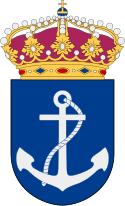Coastal Fleet
Coastal Fleet[2] (Swedish: Kustflottan, Kfl) was until 1994 a Swedish Navy authority with the main task of training the naval ships commanders and crews.[3] After the formation of the authority Swedish Armed Forces in 1994, the Coastal Fleet remained as a unit until 2000.
| Coastal Fleet | |
|---|---|
| Kustflottan | |
 | |
| Active | 1904–2000 |
| Country | Sweden |
| Allegiance | Swedish Armed Forces |
| Branch | Swedish Navy |
| Type | Naval force composed of surface combatant, minelayer, minehunter and submarine units |
| Role | Naval authority |
| March | "Kustflottans marsch" (Åke Dohlin)[1] |
| Insignia | |
| Naval Ensign |  |
History
The Swedish Navy ships were equipped for expeditions during the summer months and were organized in temporary squadrons under the leadership of the Highest Commander (högste befälhavare). In 1904 an Inspector of the Navy's Exercises at Sea (Inspektör för flottans övningar till sjöss) was also appointed, the highest commander of the coastal squadrons. From 1909 the squadrons began to be called coastal fleets. From 1919, the positions of the Highest Commander and Inspector of the Navy's Exercises at Sea (SFS 1918:868) were merged and the position of the Highest Commander of the Coastal Fleet (Högste befälhavaren för kustflottan) was created, which in turn was changed in 1931 to the Chief of the Coastal Fleet (Chefen för kustflottan).[4]
The command flag of the last Chief of the Coastal Fleet, Frank Rosenius, was lowered on 30 June 1998.[5]
Heraldry and traditions
Colours, standards and guidons
The colour of the Coastal Fleet was a double swallow-tailed Swedish flag, which was presented in 1976. It was later taken over by the Joint Forces Command.[6]
Commanding officers

Inspector of the Navy's Exercises at Sea
- 1904–1906: Wilhelm Dyrssen
- 1906–1907: Carl Olsen
- 1907–1916: Wilhelm Dyrssen
- 1916–1918: Carl August Ehrensvärd
Highest Commander of the Coastal Fleet
- 1919–1919: Carl August Ehrensvärd
- 1919–1923: Carl Alarik Wachtmeister
- 1923–1925: Fredrik Riben
- 1926–1927: Otto Lybeck
- 1927–1931: Harald Åkermark
Chief of the Coastal Fleet
- 1931–1933: Harald Åkermark
- 1933–1939: Fabian Tamm
- 1939–1942: Gösta Ehrensvärd
- 1942–1945: Yngve Ekstrand
- 1946–1950: Erik Samuelson
- 1950–1953: Stig H:son Ericson
- 1953–1957: Erik af Klint
- 1957–1961: Bertil Berthelsson
- 1961–1962: Einar Blidberg (acting)
- 1962–1966: Einar Blidberg
- 1966–1970: Dag Arvas
- 1970–1977: Christer Kierkegaard
- 1977–1980: Bengt Rasin
- 1980–1982: Bror Stefenson
- 1982–1985: Jan Enquist
- 1985–1990: Claes Tornberg
- 1990–1994: Sten Swedlund
- 1994–1998: Frank Rosenius
Flaggkaptener (Captains of the Fleet)
- 1902–1902: Sten Ankarcrona
- 1903–1903: Sten Ankarcrona
- 1903–1907: ?
- 1907–1907: Carl August Ehrensvärd
- 1907–1917: ?
- 1917–1918: Carl Alarik Wachtmeister
- 1918–1919: ?
- 1919–????: Gustaf Richard Starck
- ????–1923
- 1923–1925: Charles de Champs
- 1925–1930: Claës Lindsström
- 1930–1931: Fabian Tamm
- 1932–1933: Hans Simonsson
- 1933–1936: Gösta Ehrensvärd
- 1937–1939: Yngve Ekstrand
- 1939–1941: Helge Strömbäck
- 1941–1943: Erik Anderberg
- 1943–1945: Erik Samuelson
- 1946–1948: John Wirström
- 1948–1950: ?
- 1950–1951: Erik af Klint
- 1951–1953: Bertil Berthelsson
- 1953–1956: Einar Blidberg
- 1956–1959: Åke Lindemalm
- 1959–1964: Magnus Starck
- 1964–1966: Nils-Erik Ödman
- 1966–1971: Alf Berggren
- 1971–1973: Göte Blom
- 1973–1973: Sigurd Håkansson
- 1974–1978: Åke Johnson
- 1978–1980: Lennart Forsman
- 1980–1980: Bengt O'Konor
- 1980–1985: ?
- 1983–1985: Claes Tornberg
- 1985–1986: Gustaf Taube
- 1986–1994: ?
- 1994–1996: Olof Jonsson
- 1996–1998: Anders Stävberg
References
Notes
- Sandberg 2007, p. 204
- Appich, Jr. 1988, p. 27
- "Kustflottan". Nationalencyklopedin (in Swedish). Retrieved 20 October 2017.
- "Chefen för kustflottan (1875 – )" [Chief of the Coastal Fleet (1875 – )] (in Swedish). National Archives of Sweden. Retrieved 20 October 2017.
- Jeppsson 2009, p. 132
- Braunstein 2004, p. 36
- Braunstein 2006, p. 51
Print
- Appich, Jr., Thomas W. (22 July 1988). "REFERENCE AID SWEDISH-ENGLISH GLOSSARY OF MILITARY AND TECHNICAL ACRONYMS AND ABBREVIATIONS" (PDF). Joint Publications Research Service. Foreign Broadcast Information Service. Archived from the original (PDF) on 20 February 2017. Retrieved 9 September 2018.CS1 maint: ref=harv (link)
- Braunstein, Christian (2004). Svenska försvarsmaktens fälttecken efter millennieskiftet [The flags and standards of the Swedish armed forces after the turn of the millennium] (PDF). Skrift / Statens försvarshistoriska museer, 1101-7023 ; 7 [dvs 8] (in Swedish). Stockholm: Statens försvarshistoriska museer. ISBN 978-91-971584-7-3. SELIBR 9815350.CS1 maint: ref=harv (link)
- Braunstein, Christian (2006). Heraldiska vapen inom det svenska försvaret [Heraldry of the Swedish Armed Forces] (PDF). Skrift / Statens försvarshistoriska museer, 1101-7023 ; 9 (in Swedish). Stockholm: Statens försvarshistoriska museer. ISBN 91-971584-9-6. SELIBR 10099224.CS1 maint: ref=harv (link)
- Jeppsson, Tommy (2009). "Kustflottans historia" [History of the Coastal Fleet] (PDF). Kungl. Krigsvetenskapsakademiens handlingar och tidskrift (in Swedish). Stockholm: Kungl. Krigsvetenskapsakademien (5). SELIBR 3417415.CS1 maint: ref=harv (link)
- Sandberg, Bo (2007). Försvarets marscher och signaler förr och nu: marscher antagna av svenska militära förband, skolor och staber samt igenkännings-, tjänstgörings- och exercissignaler (in Swedish) (New ed.). Stockholm: Militärmusiksamfundet med Svenskt marscharkiv. ISBN 978-91-631-8699-8. SELIBR 10413065.CS1 maint: ref=harv (link)
Further reading
- Hofsten, Gustaf von; Rosenius, Frank, eds. (2009). Kustflottan: de svenska sjöstridskrafterna under 1900-talet. Marinlitteraturföreningen, 0348-2405 ; 94Forum navales skriftserie, 1650-1837 ; 34 (in Swedish). Stockholm: Kungliga örlogsmannasällskapet. ISBN 978-91-977973-1-3. SELIBR 11621245.
External links
- Coastal Fleet Officer Association (in Swedish)
